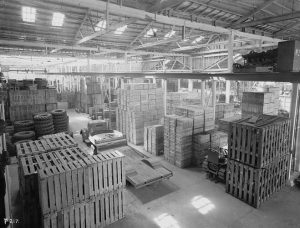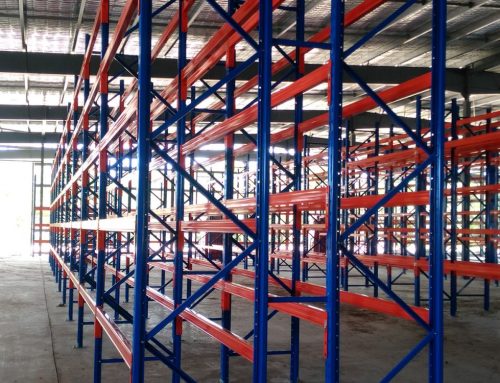Since their birth, warehouse racking systems have developed significantly. The innovations in design have improved drastically, with efficiency and safety being number one considerations that are really going above and beyond. In the beginning, Dexion pallet racking was the pioneer of warehouse racking systems and today we have contemporary, sophisticated systems available to businesses. Join us as we explore the history of the evolution of warehouse racking systems, from Dexion to modern solutions.
The Birth of Dexion Pallet Racking
Introduced in the 1940s, Dexion pallet racking was invented by Demetrius Comino, an Australian-born engineer. Dexion’s slotted angle construction changed the way that goods were both stored and handled across warehouses.
Originally, the Dexion system used pre-punched steel angles for easy assembly and disassembly. This offered both unprecedented flexibility and scalability, making it possible for warehouses to optimise the way they store everything while also improving inventory management.
The Dexion racking system was a game changer for the industry because it allowed vertical space to be used efficiently, reducing the need for expansive flooring areas. With its modular nature, Dexion racking could be customised to fit the various storage needs of a warehousing business. This made it a versatile solution for a warehouse of any size and background.

Negative from International Harvester Co at Museums Victoria
Evolution of Racking Designs
As we said, warehouse racking systems have evolved repeatedly over time. This has been driven by the need for better safety, compliance and efficiency.
Adjustable pallet racking
One of the most significant developments after Dexion is the adjustable pallet racking system. This is the type of racking that allows for the easy adjustment of shelf heights and is able to accommodate different weights and pallet sizes. These systems have improved the flexibility of warehouse storage and this allows businesses to adapt quickly.
Drive-in, drive-through racking
Warehouse managers want to maximise as much space as possible, and drive-in, drive-through systems were introduced to meet that need. These allow forklifts to drive directly into the racking structure and place and retrieve the pallets properly. These are ideal for high-density storage systems and drive-through racking offers access from both ends.
Cantilever Racking
A Cantilever racking system was developed to store longer, bulkier items. They’re good for pipes, timber, and furniture. They consist of a series of arms extending from a central column and provide easy access to the items. It’s helpful in industries where storage of odd-shaped items is a must.
AS/RS
Automated storage and retrieval systems came with the advent of automation. These are systems that use computer-controlled cranes and conveyors to automatically place and retrieve goods from storage locations. This technology has seen warehouse efficiency shoot through the roof and reduces manual labour, minimising errors and optimising the way space is used. These are excellent for high-volume warehouses.
Modern Racking Solutions
Warehouse racking systems are more sophisticated than ever before. They incorporate advanced materials with enhanced technology and design principles. Modern solutions focus on maximising storage, improving accessibility, and safety for those working with it.
Mobile Racking
Mobile racking systems are modern and designed to maximise storage space. They do this by taking down the need for fixed aisles in warehousing and they consist of racking units that have been mounted on mobile bases. These bases move along tracks, which create aisles when they’re needed most.
Mezzanine Flooring
For an additional layer of storage space, consider mezzanine flooring. They use the vertical height of the warehouse and these can be customised to support racking systems while being used to create additional office or storage space inside the warehouse.
Pallet Flow Racking
Pallet flow racking systems were created to use gravity to move pallets along a track that was sloped. It’s a FIFO – first-in, first-out – system that ensures that older stock is first used. This reduces the risk of products becoming obsolete.

Photo by Tiger Lily on Pexel
Regulatory Compliance and Safety Standards
The standards of any equipment changing has to come with better regulations and safety standards. In Australia, the Australian Standard for pallet racking AS 4084-2012 outlines the requirements for steel storage racking, ensuring that racking systems are designed, installed, and maintained to meet safety and performance criteria.
These standards cover various aspects, including:
- Load capacity which ensures that systems can safely support the load that’s intended to be supported.
- Guidelines for proper installation to prevent structural failure and accidents.
- Regular inspections and maintenance to identify and address issues.
Businesses must comply with these standards to maintain the best possible working environment. Modern racking systems are designed with these standards in mind.
From the revolutionary Dexion racking system to the advanced solutions of today, warehouse racking has come a long way. Upgrades in design have not only improved efficiency and space use, but have also changed safety and regulatory compliance for the better. As technology continues to advance, we can expect further developments in warehouse racking systems, driving the future of warehouse storage solutions.
For expert solutions and a wide range of options, visit Pallet Racking Queensland. Their comprehensive services ensure your storage needs are met with the highest standards.




